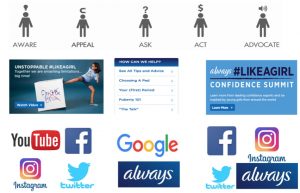Successful Persuading of Consumers to Buy through Advertising Media using Reception: A Case study of Always Keep Going #LikeAGirl.
Main Concept: Reception
Introduction
While adverts over the media contribute about 91% influence on consumer purchases, Reception is the main determinant of the success rate of an advertisement. This means that reception is on the top chain of successful influence, which will in return determine the effectiveness of the advertisement message in increasing sales of the product or service being advertised. Therefore, the main concept that will be focused in this essay is the Reception of an advertisement message.
This concept has been chosen because the observable current trend that the media is using is in publishing its adverts to persuade the consumers to buy is through Reception. By this, the advertisements that are run over the media are designed to have a message that will psychologically have a good reception on the side of the consumers.
To elaborate and illustrate the effectiveness of advertisement reception in consumer purchases, the essay will be focusing on a successful media campaign by Procter and Gamble Company on their successful Always brand. The campaign was titled Keep Going #LikeAGirl, an advertisement that has gone viral over much Social Media. I have chosen this case study because the campaign has largely benefited from reception to transform Always as the best-selling ladies’ menstrual hygiene product whilst creating a successful awareness globally and many views on YouTube.
Literature Review
2.1 Concept Review
In the current generation of digital media, audience reception is being affected by the availability of a lot of information over the internet to create consumers aware which has largely increased consumer knowledge on products, (Aitken, et al, 2008). This means that the method of audience interpretation of advertisement messages has changed from how it used to before. The Media is well aware of this and is creatively using reception of advertisement messages by consumers through the available distribution media channels to their advantage.
An audience reception theory proposed by Stuart Hall (1974) stresses that the message that the media uses in advertisement goes through two main channels of encoding and decoding, (Shaw, 2017). A company will encode the message and send it through the media to the audience then the audience after receiving the message will decode it. The real deal is always at how the audience will decode the message because different consumer audiences will decode the message differently from what the sender originally intended.
The reception, depending with the message contained in the advert and the target audience, will have a dominance reception (when the audience agrees with it), and opposed reception (when the message is negatively received by the audience), and a negotiated reception (when part of the audience agrees with the message while others do not), (Vahid, and Esmae’li, 2012). The research shows that an advert with a dominant reception has made a positive change in the thoughts of an audience which will make the consumers buy the product and hence this transforms to increased product sales. On the other hand, an opposed reception will lead to a negative view of the product by the consumers which means that the product will not be purchased and therefore will create a negative impact and consequently lead to declined sales. Lastly, a negotiated reception is neutral on the side of making an impact from the advertisement and the results will be a constant sale of the product even after the advert runs in the media.
2.2 Key Words
Under the chosen essay topic (successful persuading of consumers to buy by the advertising media through reception) the keywords that will drive the essay include the following, (Vahid, and Esmae’li, 2012);
- Reception. In this context, reception refers to how advertisement messages are decoded by the audience from the initial encoding by the media where encoding is the creation of the message contained in an advert or campaign while decoding means the act of interpreting the meaning of that message.
- Audience. In this essay, the audience is used to mean a group of consumers who are the main target of media advertisements to interpret the message sent to them inform of adverts.
- Dominant Reception. This is used in the essay to mean the positive manner in which the media wants the audience to view the advert message, where the audience will only do so if the message is clear and relate to the age, gender and culture targeted.
- Oppositional Reception. This is used to explain a situation whereby the audience has declined the dominant reception and instead creates their understanding of the meaning of the message contained in the advert. It mainly happens in case of a complex message or controversy on the theme of the message depending on cultural beliefs or age differences.
- Negotiated Reception.This occurs when the advertisement message is both dominant and oppositional before the audience. This is a case where the audience is in agreement with some of the views of the advert message but has its views on some parts of the message as well.
2.3 Relevant Concept Academic Reading.
The concept of reception has been discussed in different academic whose main is also to explain the meaning and also illustrate how the concept is relevant in different advertisements. With the help of resources from the school library and also published journals relevant to this concept and topic under global media management, the following five readings on reception have helped in defining the media advertisement concept and are key in this essay;
- Aitken, R., Gray, B., and Lawson, R. (2008). Advertising effectiveness from a consumer perspective. International Journal of Advertising,27(2), 279-297.
This reading is important in this essay as it gives a good foundation of understanding how reception from the consumers is key and its effect on the effectiveness of an advertisement.
- Cox, M. J. (2008). Sustainable communication: a study of green advertising and audience reception within the growing arena of corporate social responsibility, Case Study: British Petroleum. Earth and Environment,3, 32-51.
This reading is relevant in this essay because it helps to explain how key issues on consumer awareness that have recently that have been brought up recently affect current consumers’ reception of advertisement message with a case study on green advertising.
- Bullo, S. (2014). Evaluation in advertising reception: A socio-cognitive and linguistic perspective. Springer.
This reading by Bullo is important in this essay as it elaborates on the social effects and their impacts on reception and interpretation of advertisement messages by the target audience.
- Shaw, A. (2017). Encoding and decoding affordances: Stuart Hall and interactive media technologies. Media, culture and society,39(4), 592-602.
The reading is relevant in this essay as it helps to give insights on the encoding and decoding process of advertisement messages.
- Ebren, F., and Çelik, Y. (2011). Television Advertisements: A Reception Study. Turkish Online Journal of Qualitative Inquiry,2(3).
This study is important in this essay as the Author was also focusing on the reception of advertisement messages under the analysis of television advertisements, an analysis that will help in explaining the variables used in this essay.
2.4 Potential essay Subheadings.
From the above review, the essay case study will be analyzed under the following subheadings that will be appropriate to understand how the reception of the advert message played a great role in the success of the Always campaign Keep Going #LikeAGirl;
- The theme and reason for the advertisement.
- Encoding and content creation.
- The choice of advertisement distribution channel.
- Audience content decoding and reception.
- Impact of the reception
2.5 Relevant Case Study Reading.
To understand the case study used in this essay, the reading by Hajdas, (2017) entitled Always #LikeAGirl: Turning an Insult into a Confidence, is relevant to this case study the reading can be accessed at https://instituteforpr.org/wp-content/uploads/Always-LikeAGirl-Turning-an-Insult-into-a-Confidence-Movement.pdf. The article has critically analyzed the campaign and will be used in this essay to evaluate the reception concept of the advert.
Case study.
3.1 Case Review.
The case study in this essay is a successful advertisement campaign by Always brand entitled Keep Going #LikeAGirl.

Source: Youtube, https://www.youtube.com/watch?v=XjJQBjWYDTsandt=18s
The main expression of the ideas in the advertisement was basically under a positive reception of the hashtag #LikeAGirl which best explains why reception is important in persuading consumers to buy through media advertisement The campaign generated a lot of global awareness and went viral to get a lot of viewers on YouTube. The advert targeted mainly young girls who were entering their second phase of life and were scared about the changes occurring and how to handle them. Always responded to these with a move to make the feminine hygiene important using content that the society would unanimously agree on. The campaign has been an award-winning since it was launched in 2014 and has since then positioned this Always brand to be the best ambassador for social changes and empowerment in females. In expressing this, the brand sought to bring hope in situations where the females felt out of place and the painful moment made them lose hope and wondered how they would fit in the society. The campaign has recently been fine-tuned to advert message that encourages young girls not to be discouraged by failure but to embrace and learn from it,

Source: Protector and Gamble, https://www.always.co.uk/en-gb/about-us
As seen from the adverts, the campaign main aim was to give the feminine a motivation to feel strong and carry on with their different roles in society as usual. The community had been traditionally unengaging in this role which had led to stress and depression among many ladies. With this content, the campaign emotionally engaged ladies and with it came the sanitary towels that were well distributed globally and at cheap prices to make them affordable.
The successful advertisement that led the consumers to buy the Always product can be attributed to the reception through which the audience received the message from the advert. The content creators did a good job of understanding how the message would be received before sending it over the media. This resulted in a dominant reception which emotionally engaged the audience to agree with the message. To understand the logic behind the application of the concept of reception in this advert, the case study can be evaluated under the following;
3.2. The Theme and Reason for the Advert.
Before sending a media advert, it is important to decide on a clear topic and them so that one can understand the expected reception from the audience side, (Cox, 2008). A clear topic that is set to address certain challenges in the community is likely to generate a dominant reception than a topic that challenges how the society does things which probably will generate an oppositional reception. Similarly, a topic not well designed and unclear to some of the audiences on which issue it will be addressed will likely generate a negotiated reception, which is not an aim in any media advert, (Weeks and Holbert, 2013). As seen, the content creators of the Always media advertisement had an important issue which the campaign sort to address under the theme of boasting girls’ confidence. The pictorial representation of the advertisement solely sold out the theme and the main idea to the public as seen below;

Source: marketing news, http://ethicalmarketingnews.com/past-campaigns-always-likeagirl-unstoppable
As the theme of the campaign was to give confidence to ladies by making them brave in situations when their self-esteem went low, the campaign pictures that ran over the media played this role very well and was well-received by the audience.
3.3 Encoding and Content Creation.
After finding the best theme for the advertisement, media advertisement then strive to achieve a dominant reception. To realize this, the advert has to be well encoded so that the audience can decode the message correctly, (Gong, 2018). This is achieved through the creation of relevant content that will be engaging to the target audience so that they can see and interpret and visualize the situation in the manner that the content creator deems best to solve the issue under consideration.
In this advertisement, Always noted that a considerable percentage of young girls felt that society limits them. During puberty, almost 50% of the girls feel incapacitated to do things by the fear of failure which in return leads to the lack of confidence to try new things or even continue with their daily activities comfortably. This idea was used by Always to encode a message in their advert that empowered females to overcome the fear and to ‘Keep Going like a Girl as demonstrated in these videos;

Source: YouTube, https://www.youtube.com/results?search_query=Keep+Going+%23LikeAGirl
The encoded message in this video was mainly to encourage girls’ confidence, which in this case is the most essential topic to discuss with this target audience. In the videos, Always is providing advice and suggestions for the girls to know more about their current body changes and how to take them and have a confident mind. The encoded message relates to their main theme of championing girls’ confidence, a step which is key to receive a dominant reception.
3.4 The choice of advertisement distribution channel.
To achieve the best reception of the media advert, the choice of the distribution channels is important for the message to reach its intended audience, (Ebren, and Çelik, 2011). For this particular advertisement campaign, Always knew that most of these girls at puberty and in this internet era are plenty available on social media and frequent internet visitors. Always, therefore, choose the following main channels for the advert;

Source: Medium, https://medium.com/@yw2467/why-always-likeagirl-is-so-successful-643a6e6fe83
YouTube, Instagram, Facebook and used Twitter to promote its hashtag #LikeAGirl stories and videos. Influencers and Bloggers over the internet were also paid to spread its endless stories and videos over the internet as well as perfect use of their official website and Google SEO to reach their audience.

Source: Always, https://www.always.co.uk/en-gb/tips-and-advice-for-women
Always has also a whole section on their website that engages the community to discuss how to boost the confidence of girls;
3.5 Audience content decoding and reception.
This point at which the success of the advertisement is determined since the advert message is available over the media and the only left option is for the audience to decode the message and offer their reception, (Bhogal, et al, 2019). When the target audience, (puberty girls), sees the advertisement videos and stories under the hashtag #LikeAGirl, they become aware of the changes they are experiencing. They also become aware of this brand since the content in the video and stories behind are emotionally touching and engaging, which empowers them and re-ignites the confidence in them. From the study of this audience before and after they receive these advertisement messages, they feel understood and valued which champions them to be strong at this stage in life. Such a reception is dominant and has led to the sharing of the stories and videos with more google visits by the audience to the official website to know more about this product. The brand does not disappoint since in response it offers more information and also more product that females can use to champion their confidence as shown below;

Source: Always, https://www.always.co.uk/en-gb/feminine-products
The positive decoding of the message which leads to a dominant reception of the advert has been the key to the success behind the positioning of Always brand in the society.
3. 6 Impact of the reception
Following the advert message and agreeing to it, females have in return used these Always products and felt more comfortable. This has enabled them to smoothly continue with their day to day activities successfully and it is because of these they also turn to social media and spread the hashtag #LikeAGirl to empower more and more girls who might be in a similar situation.

Always, https://www.always.co.uk/en-gb/tips-and-advice-for-women/mums-and-daughters
These have enabled the brand to secure a very big share of the girls’ hygiene market which can solely be attributed to the empowering global media advertisements that contain valuable content and transferring it via efficient channels. The message was well accepted, not only by the target audience but also by men and women as well as media houses from all over the globe to help encourage the girl child through the positive #LikeAGirl movement. Even the NGOs acknowledged the movement which has seen the brand become an award winner in empowering females all over the world.
Conclusion.
The concept of reception is very important in media adverts. How the audience receives and interprets the advertisement message or text is a key determinant of the success of this advert, (Förster, 2015). A successful advert will achieve the goals of making the advert which in this case is to increase product sales and better position the product in the market. For the advert to be successful, the creator of the content has to understand how the target audience is likely to interpret the message created. This is done by selecting a good theme to be addressed and the issue being addressed should at best be a solution to an existing issue in the society. When addressed well, it reads to a good reception as opposed to a theme that opposes how the society does things, (Weeks and Holbert, 2013). Depending on the type of society and their culture, the advert may create a mixed reception (a negotiated reception which is a mixture of both dominant and oppositional reception). This may not work very well to realize the goal of the advert.
The case study has analyzed a media advert by Always, which took a keen consideration of the weight from the type reception that an audience can give and the power it has in turning a product into a social brand. Always considered this fact and created a content in their media advert that was positively received. The dominant reception has kept its initiatives and events relevant to not only its specific customers but also the whole society as an audience at large. The basic concept of reception in media advertisements has been used to transform the brand into an award winner.
References
Aitken, R., Gray, B., and Lawson, R. 2008. Advertising effectiveness from a consumer perspective. International Journal of Advertising, 27(2), 279-297.
Bhogal, K.S., Boss, G.J., Comes, S.L., Hamilton, I.R.A. and Sand, A.R., International Business Machines Corp, 2019. Consumer-configurable alternative advertising reception with incentives. U.S. Patent Application 10/284,921.
Bullo, S. 2014. Evaluation in advertising reception: A socio-cognitive and linguistic perspective. Springer.
Cox, M. J. 2008. Sustainable communication: a study of green advertising and audience reception within the growing arena of corporate social responsibility, Case Study: British Petroleum. Earth and Environment, 3, 32-51.
Ebren, F., and Çelik, Y. 2011. Television Advertisements: A Reception Study. Turkish Online Journal of Qualitative Inquiry, 2(3).
Förster, K. 2015. An audience-centered perspective on media brands: Theoretical considerations, empirical results and ‘White Spaces’. In Handbook of media branding (pp. 281-293). Springer, Cham.
Gong, Q. 2018. Communicating risk and protection: advertising discourse of young children’s healthcare products and parental reception in China. European Journal of Cultural Studies, 21(2), 223-241.
Protector & Gamble, 2019. Always brand, accessible: https://www.always.co.uk/en-gb/about-us
Shaw, A. 2017. Encoding and decoding affordances: Stuart Hall and interactive media technologies. Media, culture and society, 39(4), 592-602.
Vahid, H., and Esmae’li, S. 2012. The power behind images: Advertisement discourse in focus. International Journal of Linguistics, 4(4), 36.
Weeks, B. E., and Holbert, R. L. 2013. Predicting dissemination of news content in social media: A focus on reception, friending, and partisanship. Journalism and Mass Communication Quarterly, 90(2), 212-232.
YouTube, 2019. Keep Walking #LikeAGirl media advert; accessible at https://www.youtube.com/watch?v=XjJQBjWYDTsandt=18s
